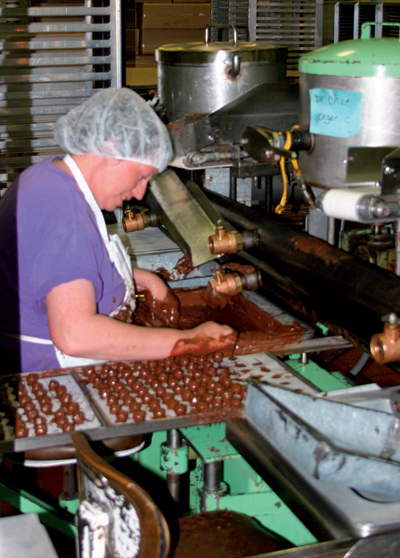MEDC Russell Stover Candies
Feature article.
dawning of a new era
Russell Stover Candies
Story and photos, Kathryn R. Burke
 [Montrose Economic Development Corporation, 50th Anniversary Publication]
[Montrose Economic Development Corporation, 50th Anniversary Publication]
“When Russell Stover Candies came to Montrose in 1976, it marked the dawning of a new era,” said MEDC Executive Director, Sandy Head. “Providing a second income for farm families, the successful establishment of the candy company proved to the community that Montrose could be home to a large manufacturer. Two years later, when Holly Sugar pulled its sugar beet processing out of the valley, it took with it one of the largest income crops on the Western Slope.The 200-plus jobs that Russell Stover provided proved even more valuable.” Today, the company employs more than 600 people here.
It’s a sweet operation, and now one of the biggest in western Colorado. Three shifts working in a 300,000 square foot facility produce more than 15,000,000 pounds of candy for what amounts to a five-month selling season. “Most of our product is sold for Christmas, Valentine’s Day, and Easter,” explained Plant Manager Paul Minerich. And much of that is made ahead of time to meet a growing national and international market.
Successful establishment of the candy company proved to the community that Montrose could be a home to a large manufacturer.
The Montrose plant—the others are in Kansas and Texas—and candy-making process are huge. Sugar arrives by rail car, the contents “blown” into 137,000 pound silos. Chocolate, shipped in as ten-pound cakes (1,800 pounds per palette) is stored, tempered by heating to 120 degrees Fahrenheit, blended to a special formula, then cooled to below zero and stored in a vast refrigerated room the size of a football field. Nuts and dairy products (both possible allergens to employees) have their own storage and processing areas. Mixers bigger than a six-foot tall man whip up cremes and fillings. In-progress candies travel along conveyer belt-assembly lines that crisscross the plant like a slow-moving roller coaster, as ingredients are added, confections coated or hand-dipped in chocolate, then tempered, cooled, tooled and packaged, and stored in temperature-controlled rooms. The plant even has its own box-making facility.
 And all this from the Eskimo Pie (invented by Russell Stover’s business partner in 1921) and Clara Stover’s “Bungalo Candies,” first produced in 1923 in Denver when the Stovers became a privately held candy manufacturer. Today, run by the Ward family, who acquired it in 1960 and now also own Whitman’s and Pangburn’s, Russell Stover produces a variety of products including Weight Watcher, Net Carb, sugar-free candies, and their long-standing favorite, boxed chocolates. The company is the nation’s leading manufacturer of boxed chocolates.
And all this from the Eskimo Pie (invented by Russell Stover’s business partner in 1921) and Clara Stover’s “Bungalo Candies,” first produced in 1923 in Denver when the Stovers became a privately held candy manufacturer. Today, run by the Ward family, who acquired it in 1960 and now also own Whitman’s and Pangburn’s, Russell Stover produces a variety of products including Weight Watcher, Net Carb, sugar-free candies, and their long-standing favorite, boxed chocolates. The company is the nation’s leading manufacturer of boxed chocolates.
This article appeared in the Montrose Economic Development Corporation, 50th Anniversary Publication, 2007, which we published for them. During that time, I had an office in the MEDC headquarters, so my staff and I could work closely with Sandy Head, MEDC Executive Director.
___

 © Kathryn R. Burke
© Kathryn R. Burke




 © Kathryn R. Burke
© Kathryn R. Burke © Kathryn R. Burke
© Kathryn R. Burke © Kathryn R. Burke
© Kathryn R. Burke